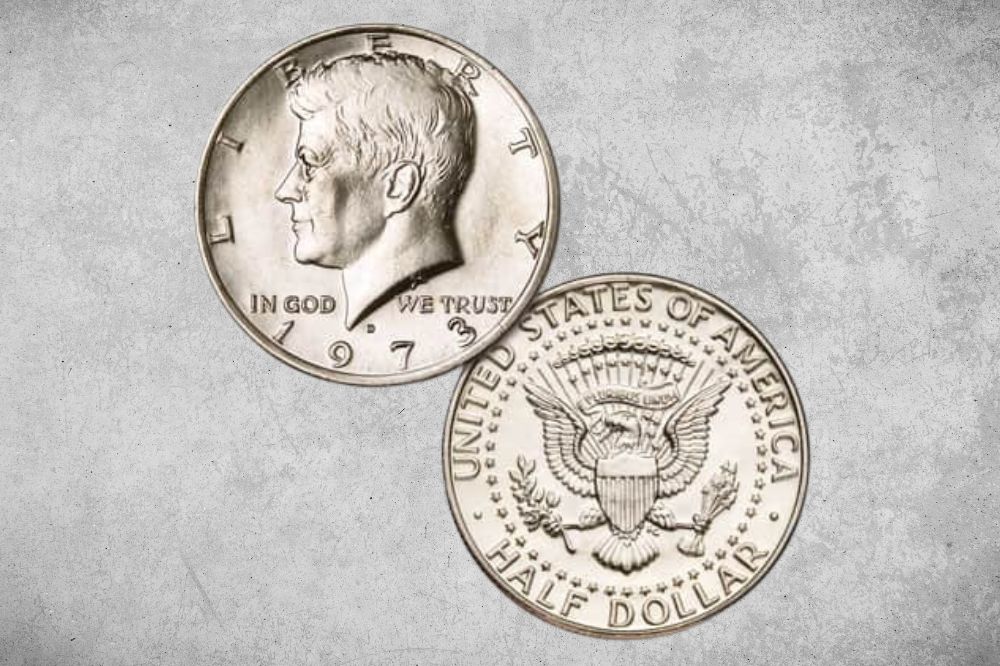The Kennedy half dollar is the most common coin in circulation in the US today and has been for decades. This doesn’t mean that specific variants and years of half dollars can’t be interesting or even monetarily valuable, however, so we should never ignore a cool coin, particularly when it’s in an especially good condition and has some interesting peculiarities or errors about it.
1973 Half Dollar Details
- Category: Kennedy Half Dollars (1964-Date)
- Mint: Denver, Philadelphia, San Francisco
- Mintage: 150,895,739
- Obverse Designer: Gilroy Roberts
- Reverse Designer: Frank Gasparro
- Composition: Copper-Nickel Clad Copper
- Diameter: 30.6 mm
- Edge: Reeded
- Weight: 11.34 g
1973 is the 10th consecutive year the US Mint had printed the Kennedy half dollar. Producing this coin began in early 1964, mere months after President J.F. Kennedy was shot. Switching to Kennedy for the 50-cent coin was done to commemorate the late POTUS and it’s been going on for decades since.
This didn’t mean an increased mintage, however, as fewer half dollars were minted in 1973 than in the few preceding and few following years. So, let’s find out what this means for the value of the 1973 half dollar and what else is interesting about it.
1973 Half Dollar Value Chart and Grading
1973 Half Dollar Value Chart |
||||||
| Mint mark | PO 1 to AU 58 | MS/PF 60 to 63 | MS/PF 64 to 66 | MS 67 | MS 68 | PR 70 |
| 1973 (P) No Mint Mark Half Dollar Value | $0.60 | $1 to $7.50 | $10 to $50 | $285 | n/a | n/a |
| 1973-S Proof Half Dollar Value | n/a | $1 to $7.50 | $10 to $50 | n/a | n/a | $4,887+ |
| 1973-D Half Dollar Value | $0.60 | $1 to $7.50 | $10 to $50 | $1,000+ | $11,000+ | n/a |
Given how common Kennedy half dollars are to this day, it’s quite normal that the vast majority of them wouldn’t be worth much more than their face value or their melted value. Once we start looking at 50-cent coins that are of truly great visual quality, meaning that they have close to or virtually no wear and tear, that’s when the price starts getting a bit higher.
Using the Sheldon coin grading scale, we can say that 1973 half dollars that are below the AU 58 grade just won’t be worth more than their face value, or, in many cases won’t even be worth that. Once we start going above the MS/PF 60 quality line, a 1973 half dollar can start bagging a price tag several times its original value.
For a truly valuable 1973 50-cent coin, however, you’d need to find something that’s above the MS 67 quality line which is incredibly rare. For a visual guide on how evaluating a half dollar works, here’s a nice video to check out.
1973 Half Dollar Value and Varieties Guides
1973 Half Dollar (P) No Mint Mark
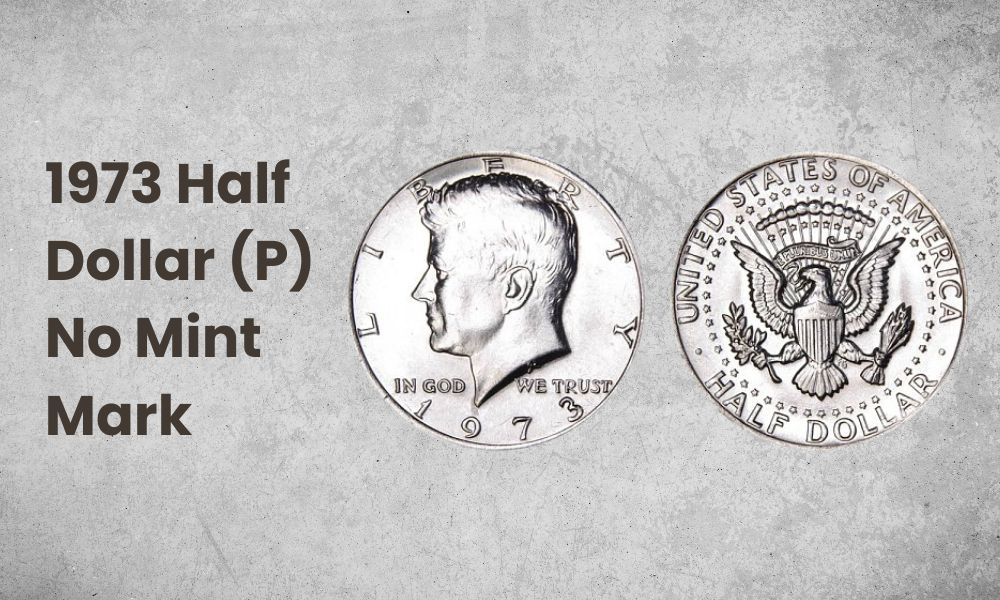
- Place of minting: Philadelphia
- Mint mark: No mint mark
- Year of minting: 1973
- Quantity produced: 64,964,000
One of the two Mints that produced Kennedy half dollars for wide circulation is the Philadelphia Mint. Coins minted there traditionally carry the “P” mint mark on them so that people know where the coin was made.
Interestingly enough, however, the 1973 half dollar (P) mintage didn’t have any mint mark – neither a “P”, nor the initial of the coin’s designers or anything similar. This has misled many people over the years into thinking that they’ve got a rare coin with a “no mint” error but that’s simply how all ~65 million of the 1973 Philadelphia half dollars were made.
1973 Half Dollar (D)
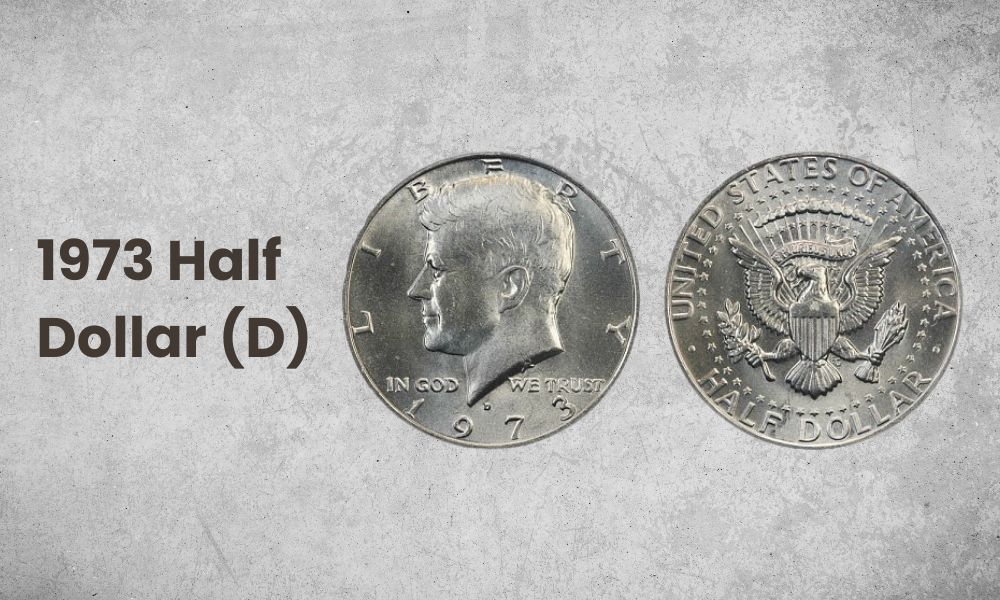
- Place of minting: Denver
- Mint mark: (D)
- Year of minting: 1973
- Quantity produced: 83,171,400
The other major mintage of half dollars in 1973 came from Denver. Striking over 83 million 50-cent coins that year, the Denver Mint didn’t skip on its traditional “D” mint mark so these coins are quite easy to distinguish.
1973 Half Dollar (S) Proof
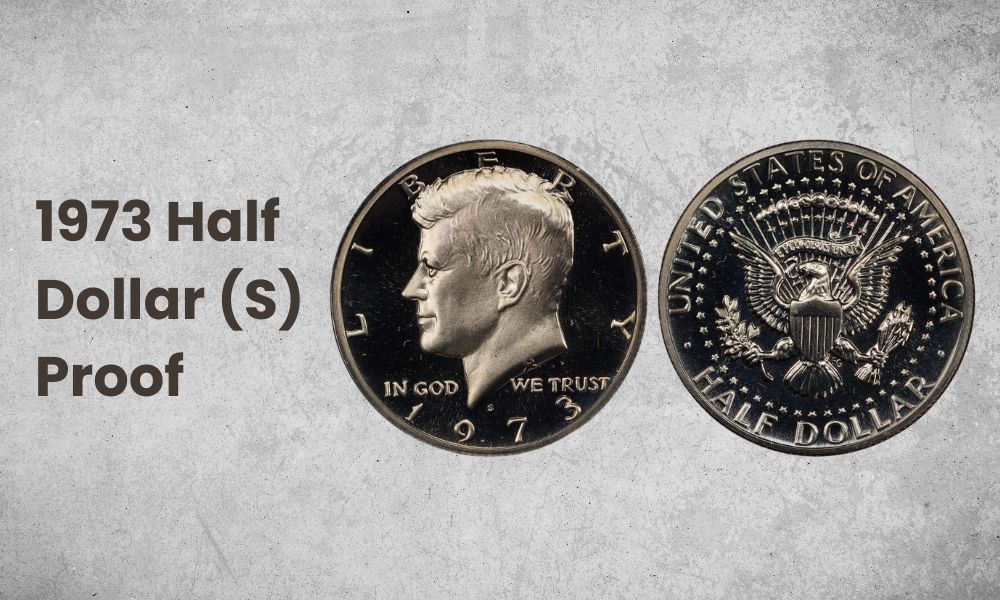
- Place of minting: San Francisco
- Mint mark: (S)
- Year of minting: 1973
- Quantity produced: 2,760,339 proof coins
The San Francisco Mint doesn’t traditionally strike Kennedy half dollar coins for wide circulation but it does strike proof coins from time to time. This was the case in 1973 when the San Francisco Mint struck nearly 3 million Kennedy half dollars proof coins with the “S” mint mark on them.
As you’d expect, these proof coins can sell for a good chunk of money today if they are well-preserved, although the record for a 1973 half dollar still belongs to an MS 68 half dollar from the Denver Mint that sold for over $11,000.
Also Read: Top 15 Most Valuable Kennedy Half Dollar Worth Money
1973 Half Dollar History
The US Mint has been striking half dollars ever since 1794 and has been changing their designs and appearance roughly once every few decades. One such change was necessitated in 1964, a few months after the assassination of the US President John F. Kennedy.
Unlike as is the case with most other coins, the Mint was extraordinarily quick with designing the coin and putting it into production as every effort was made to commemorate the late president as soon and as well as possible. In fact, the suggestion of JFK replacing Benjamin Franklin on the half dollar coin was made and accepted just hours after the assassination on November 22, 1963.
What’s more, the design of the portrait for the coin was also already approved by Kennedy himself – it was the design made by Gilroy Roberts for the Presidential Medal Series that the Mint makes for every president and that Kennedy had already given his nod for. There was only one minor detail made on the design by Kennedy’s widow, Jackie Onassis, which was to smooth some of the lines on Kennedy’s hair.
With such a quick approval process, the coin went straight to mintage and was ready in early 1964. From there, the Kennedy half dollar continued being struck for wide circulation until 2001 and was then once again resumed in 2021.
What makes the 1973 half dollar special and different from all the other Kennedy 50-cent coins, however? Well, not much, really, aside from small things such as the lack of mint marks on the Philadelphia mintage or the extra San Francisco proof coins being minted that year.
Another noteworthy thing is that there is no silver in the 1973 half dollar. That’s because the Mint stopped using silver two years earlier, in 1971, and move to a nickel and copper combination – 91.67% copper and 8.33% nickel to be exact. The core of the coin is made of 100% copper while the top layer is a combination of 75% copper and 25% nickel to achieve the right color and durability.
Prior to that, the original 1964 Kennedy half dollar was made with 90% silver as had been the norm for nearly two centuries before that. In 1970, the Mint moved to an alloy that only had 40% silver to save money and then, a year later, silver was taken out of future mints altogether.
Interestingly enough, earlier Kennedy half dollars that were still made with silver are quite difficult to find today because people stashed them. At first, in the mid 60s, this was done because people wanted mementos from their beloved president. Once the price of silver started going up in the late 60s, however, they kept stashing these coins for that reason as well.
In fact, even once the Mint stopped putting silver in coins, people still kept stashing them for a while. Still, if you’re wondering whether your 1973 Kennedy half dollar has any silver in it – the answer is a “No” but that also isn’t the first year of non-silver coins so it’s not something extraordinary.
So, if this coin is so common and widespread, what does make a 1973 half dollar valuable other than its hopefully good condition? As with any other coin – it’s certain rare errors during the coin’s production.
Lists of 1973 Half Dollar Errors
1973 half dollars have been struck with any of the errors numismatists know from other coins – an off-center strike, a die break error, and others. Here are 5 of the ones you’d want to keep an eye out for:
1973 Half Dollar Cud Error
Also known as a die break error, this occurs when the die used to strike the coin is too old and damaged. When that happens, whatever wear and tear flaws have appeared on the die, they can transfer onto the coin’s planchet. For example, if the die is cracked or has any slashes or gashes, those defects can then appear on the coin as if they were part of the design. Alternatively, such cracks can outright cut parts of the print.
1973 Half Dollar DDO Error
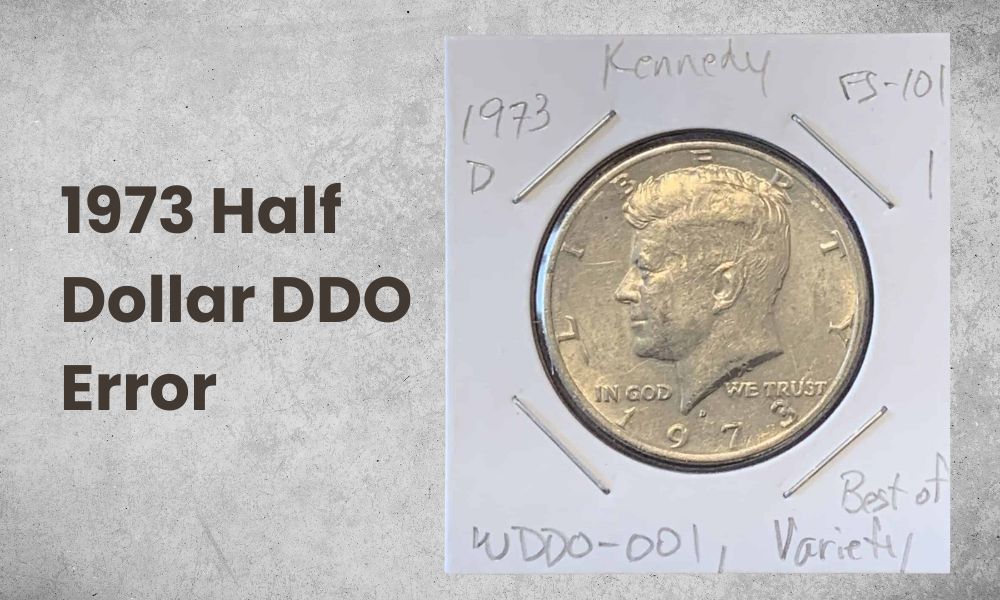
A DDO or a Double Die error is what happens when the hub of the die is striking the master copy of the coin. If there is even the slightest shift of the master copy between the strikes of the hub, the resulting die will be “doubled” and will then go on to produce coins with a DDO error.
Such errors can be easily visible or a bit harder to spot, depending on how major the shift was. More often than not the error will be tricky to spot, however, as major issues in the die are usually noticed on the spot. Still, the easiest way to see even a minute DDO error is in the letters or numbers on the coin.
1973 Half Dollar Double Strikes Both Off-Centre Error
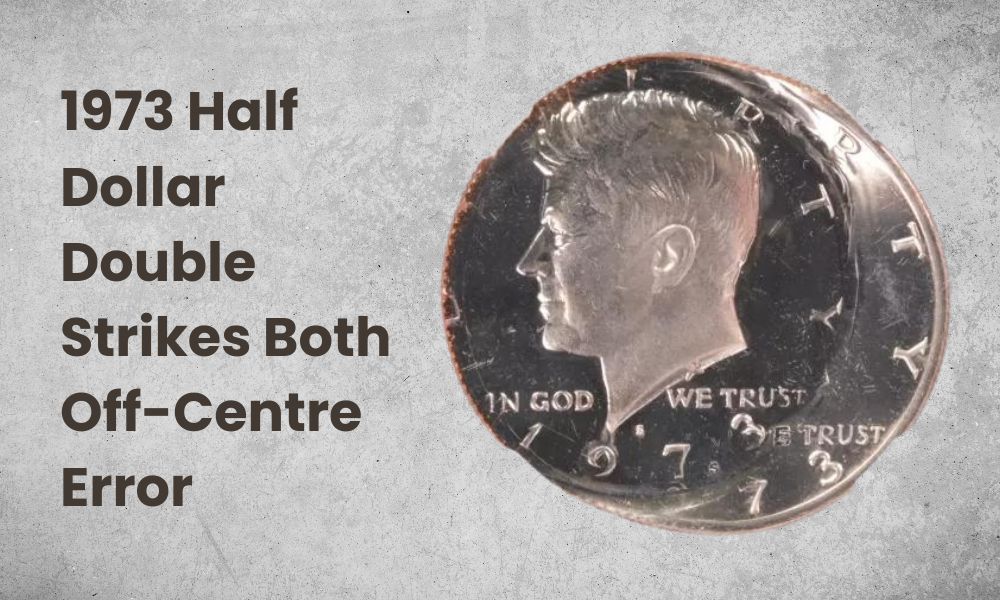
This error is similar to the DDO error but this one happens when the coin moves slightly while it’s being minted (whereas a DDO is when the master coin moves while the die’s hub strikes it). In the case of a double strikes off-center error, the design of the coin gets minted off-center, and/or it can be doubled or tripled.
1973 Half Dollar Double Denomination Error
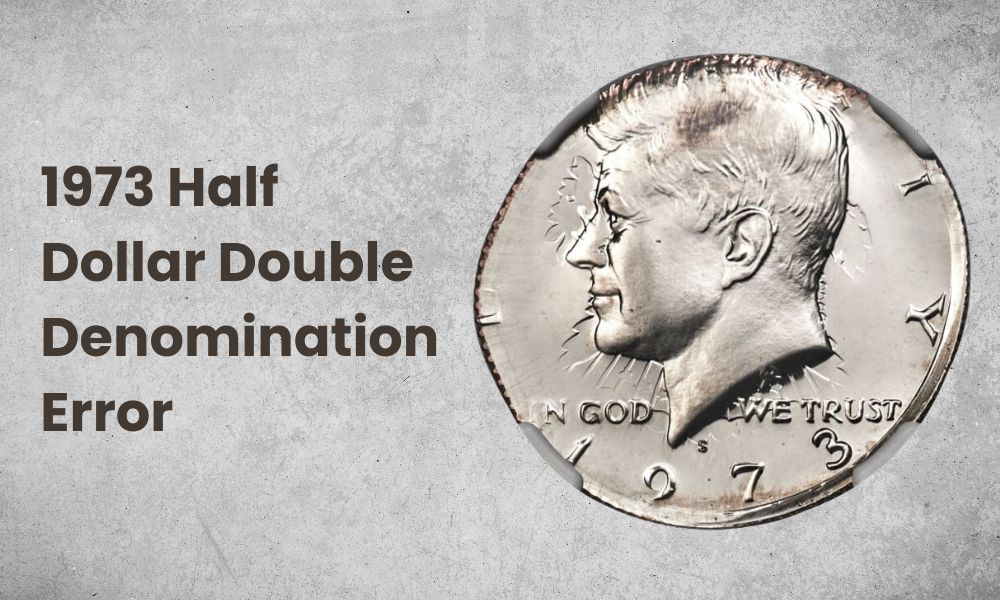
In some rare cases, a die gets stamped on an already-minted coin. In even rarer cases, such a coin is of a different denomination. For example, the $11,000 (D) 1973 half dollar we mentioned above – that was a coin with a double denomination error because it was accidentally minted on top of a 1972 C 25-cent coin.
1973 Half Dollar Five-Strike Error
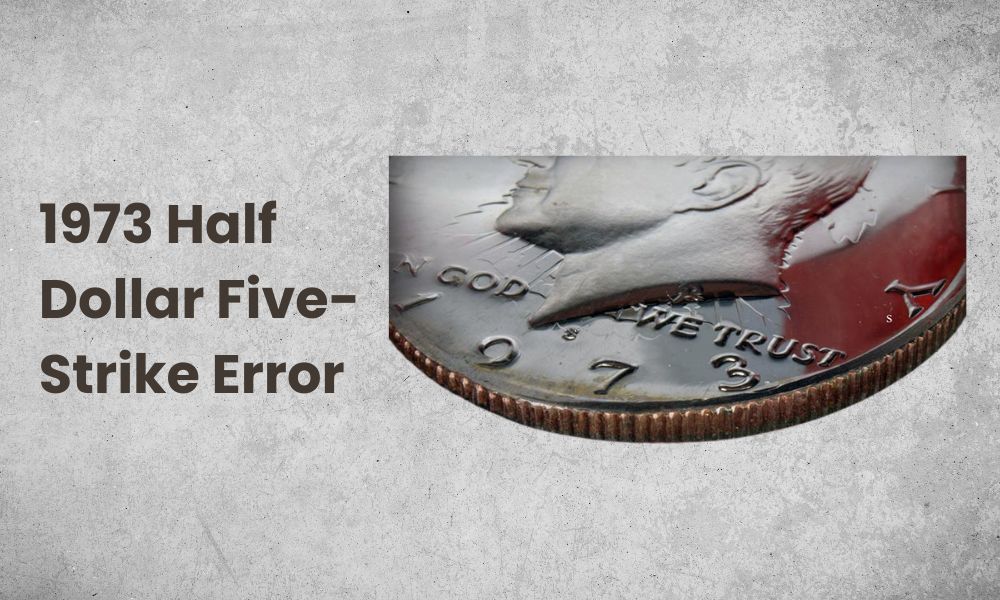
This is effectively the same type of error as the double strikes off-center error, only here we’re talking about five off-center strikes on the same coin. Such extraordinarily rare coins can look like they’ve been minted with a series of half-moon crescents nestled into each other. A rare example of a 1973 half dollar with a five-strike error was sold in 2020 for $4,320 on an auction.
1973 Half Dollar FAQ
Is the 1973 Half Dollar Rare?
Not really – while the 1973 mintage wasn’t as huge as others that came before or after it, it was still over 150 million coins that went into circulation. Not all of those are around today but plenty still are. Chances are that most of us have held a 1973 half dollar at some point – or numerous times – in our lives.
Does the 1973 Half Dollar Have a Mint Mark and Where?
The mint marks of 1973 half dollars are where mint marks usually are – on the obverse side, just beneath the president’s bust and between the words “God” and “We”.
The reason the mint mark can be tricky to find on some 1973 half dollars is two-fold – 1) these are big coins so the mint mark is tinier in comparison with other smaller coins, and 2) the 1973 half dollars minted by the Philadelphia Mint didn’t have a mint mark at all.
How much silver is in a 1973 50 cent piece?
There is exactly zero silver in a 1973 half dollar. If you have a 1973 half dollar with some actual silver in it then it’s either a fake or you’re mistaken as these coins were made with copper and nickel only.
